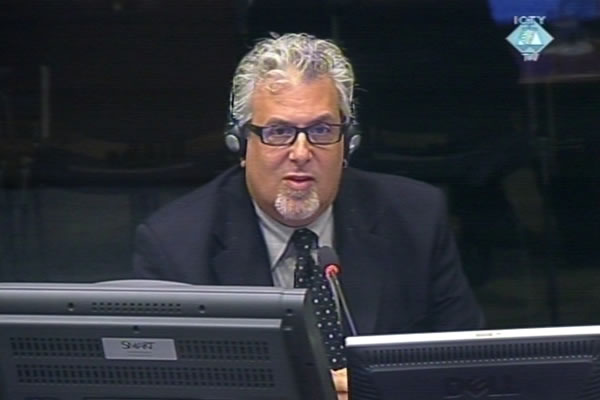Home
MASS MURDERS WERE NO SECRET ON EITHER SIDE OF DRINA RIVER
War reporter from the London newspaper The Independent is testifying at the trial of Radovan Karadzic. After seeing videos made by Zoran Petrovic Pirocanac, the witness published an article about the ‘horror in Srebrenica’ on 17 July 1995. The airing of the video made the Republika Srpska president angry, the witness said. The RS authorities quickly seized Pirocanac’s videos. The mass murders after the fall of Srebrenica were no secret on either side of the Drina river
 Robert Block, witness at the Radovan Karadzic trial
Robert Block, witness at the Radovan Karadzic trial Robert Block, a former US journalist, gave evidence at the trial of Radovan Karadzic. On 17 July 1995, Block published an article about the ‘horror in Srebrenica’ in the London newspaper The Independent. On 16 July 1995, Block watched a video recording Zoran Petrovic Pirocanac had made in Srebrenica immediately after the fall of the enclave on 13 and 14 July 1995.
As Block and his Serb colleague Dragan Cicic watched the film about the ‘liberation of Srebrenica’ and Pirocanac’s raw footage,they saw a pile of 20 to 25 bodies in front of the warehouse of the Kravica farm and the detainees on the balcony of the white house in Potocari. The day Block’s article was published, the video disappeared. Pirocanac told Block and Cicic the next day that Karadzic had been ‘very angry’ that the material had been published. Block’s friend, ‘driver and interpreter’ from Pale, whose identity the witness didn’t want to disclose, also told him that Karadzic had been ‘furious’ about the footage from Srebrenica.
In search for more information, Block and Cicic drove to the bridge between Ljubovija in Serbia and Bratunac in BH. There they learned that the mass murders in the Srebrenica enclave were no secret at all, as people in the street knew about it on both sides of the river Drina. A woman who told them she was a wife of Serb officer was surprised when they asked her about what had happened because she thought it was general knowledge. The woman spoke about the men detained in hangars, playgrounds and schools, saying that the ‘worst of them’ had had ‘their throats slit’, while the rest were killed. All those who wanted to take revenge were invited to take part in the executions. The residents of Banja Koviljaca told Block and Cicic that on the other bank of the river they saw people being unloaded from the trucks and killed; there were backhoes there too that covered the bodies with dirt.
Karadzic wanted the judges to strike from the record the parts of the witness’s statement where he said Karadzic had been furious about the report on Srebrenica. As Karadzic argued, this was ‘hearsay’. The Trial Chamber overruled his objection. The judges ordered Block to testify about this issue in court in order to be able to assess that part of Block’s evidence. The prosecution noted that the witness’s claims were consistent with other exhibits already in evidence, such as Karadzic’s personal organizer from 1995 and his speech in the assembly on 6 August 1995.
In his speech in the Assembly Karadzic complained that Lieutenant Colonel Milutinovic had provided certain information to the foreign media, most probably in exchange for money. ‘I don’t care if he has taken 25,000 German Marks or not, but he has given the foreign agencies terrible photos that may cost Mladic his life if they end up in The Hague’, Karadzic said. The prosecution alleges that Karadzic’s speech in the assembly didn’t necessarily refer to Pirocanac’s footage.
In the cross-examination, Karadzic tried to contest the claim that he had anything to do with the disappearance of the Srebrenica video footage. As Karadzic said, at the time ‘and to this day’, the Studio B TV network was and has been Republika Srpska’s political adversary. The witness replied that in his view Studio B was like a ‘chameleon’, advocating the Greater Serbia idea; Pirocanac’s report was supposed to show the VRS operation in Srebrenica in a positive light. According to the witness, when the footage was aired, no one actually imagined that the report might be harmful.
Karadzic told the witness that in 1995 he was at odds with Slobodan Milosevic and, even if he had wanted to, he couldn’t have gotten the tapes. ‘Despite the fact that Milosevic didn’t like you he would have swallowed his pride and tried to give you what you needed in order to keep Republika Srpska alive’, the witness replied. Karadzic quoted Pirocanac’s evidence before the Tribunal; Pirocanac told the judges that Momcilo Krajisnik had asked for a copy of the news report. After watching it, he told Pirocanac it was ‘well done’, Pirocanac testified. What matters is that the footage was sent to Pale and the original was never seen again, the witness insisted.
After Karadzic’s attempt to attribute the reports about the executions of Muslims in the Srebrenica enclave to the usual wartime ‘exaggerations’ and isolated cases of revenge failed, the accused showed the witness some documents which purport that the RS security service suspected the witness of espionage while he was in the region. ‘Cool’, the witness tersely said.
After Block completed his evidence, the prosecution called Milan Lesic. Lesic is one of the founders of a Serbian humanitarian organization in Canada that collected humanitarian aid for Republika Srpska during the war.
Linked Reports
- Case : Karadzic
- 2012-02-16 KARADZIC AND ‘LAWS OF CHAOS’
- 2012-02-15 KARADZIC BLAMES ‘PERSONAL VENDETTAS’ AND ‘NON-PROFESSIONAL ARMIES’
- 2012-02-14 THE ONLY QUESTION WAS WHERE TO EXECUTE THE PRISONERS
- 2012-02-22 KARADZIC’S AND MLADIC’S GIFTS TO THEIR ‘BROTHER’ IN CANADA
- 2012-02-23 WITNESS: KARADZIC RECEIVED REPORTS FROM CORPS LEVEL
- 2012-02-24 KARADZIC: I DIDN’T KNOW ABOUT CRIMES IN SREBRENICA
